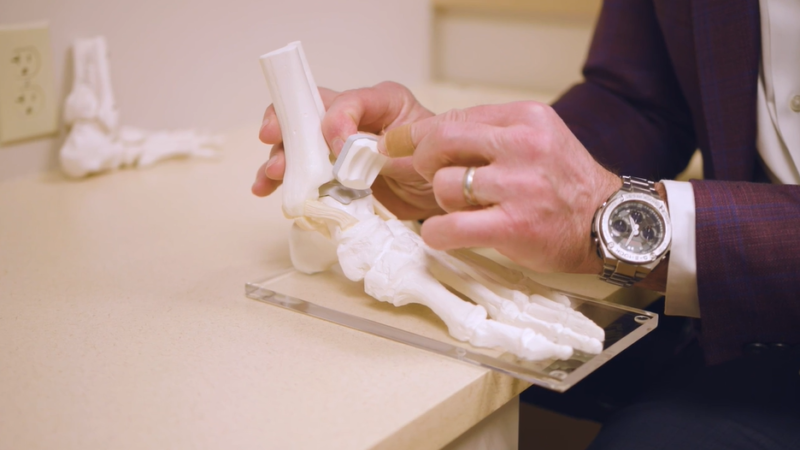
WHAT IS TOTAL ANKLE REPLACEMENT?
Total ankle replacement, or ankle arthroplasty, is a procedure where the damaged parts of the ankle are replaced with an artificial implant. Ankle replacements offer patients more mobility than fusion, and relieve the pain of arthritis. The prostheses is modeled after human anatomy and helps to reproduce natural movement of the ankle. Ankle replacement surgery is recommended after conservative treatment options such as medications, injections, and physical therapy have not helped.
ANKLE ARTHRITIS
There are three common forms of arthritis that affect the ankle joint:
Osteoarthritis is common in older adults. It is also known as degenerative or “wear and tear” arthritis. The protective cartilage wears away over time, resulting in bone rubbing on bone and ankle pain.
Rheumatoid arthritis is an autoimmune disease where the immune cells attack the joint lining. It can also attack the ligaments and tendons and cause serious joint disability.
Posttraumatic arthritis often occurs after an injury to the foot or ankle, such as a motor vehicle accident or sports injury.
Ankle arthritis symptoms can include one or more of the following:
- Swelling and tenderness
- Increased pain with movement in the morning or after sitting
- Pain flares up with activity
- Difficulty in walking
DIAGNOSIS
Your orthopedic surgeon will examine your foot and ankle for swelling and tenderness, do a gait analysis, and ask about your medical history. Generally, x-rays are taken to provide a detailed picture of your foot and ankle structure. There is no cure for arthritis, but treatments are designed to relieve pain and restore motion.
TREATMENT OPTIONS
Nonsurgical treatments include modifying your lifestyle, physical therapy, braces, orthotics, and non-steroidal anti-inflammatories (NSAIDS).
If your pain is not relieved with conservative treatments, your doctor may recommend a total ankle replacement. During this surgery, your orthopedic surgeon will make an incision on the front of the ankle. The diseased cartilage and bone are then removed from the tibia and talus. Lastly, a metal and plastic implant is inserted. Sometimes additional procedures are performed depending on the extent of your arthritis and ankle injuries.
In this video, foot and ankle surgeon, Dr. Anthony Hinz, discusses ankle replacement surgery including the recovery process.
Video Transcription:
Dr. Hinz explains that not everybody comes in with a specific diagnosis of ankle arthritis. They’ll have vague complaints, so x-rays are taken to better understand the issue.
“The things that I do conservatively are things like bracing,” explains Dr. Hinz. “Some patients may benefit from using a brace or injection therapy. A corticosteroid does extremely well in managing swelling and pain, and oftentimes for months and months at a time.” He also suggests activity modification such as inline motion gliding and low impact activities. “You’re going to get more mileage out of that ankle and have less pain than things like running and jumping sports.”
Dr. Hinz goes on to say, “Total ankle replacement, in general, is really well-tolerated, pain-wise. I’d have to say that patients have far less pain with their surgery than an ankle fusion, or even an ankle fracture repair. Patients are in a splint for a couple of weeks, come in and get their stitches out, get an x-ray, and then go into a cast for about another four weeks. They are non-weight bearing for a total of six weeks total and then they transition to a walking boot. They will start some PT, usually stay in the boot for about another four weeks, and then back to shoe wear. I tell patients that they’ll change and improve rapidly at first, and then it’s kind of a slow, steady rise over the course of about eight to 12 months.”





